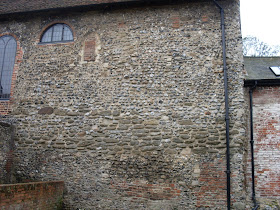The further
misadventures of our hapless palaeographer...
She watched spellbound as it dripped steadily downwards. Continuing
to watch as it was painstakingly drained of its life force. And she did not
blink as the brownish stains splashed haphazardly across the cooling surface.
Unconsciously she rubbed at her hands like some student
actor playing Lady Macbeth. Yet she could not rub out the feeling of that warm
stickiness that had stained her fingers red. That poor man, she thought,
suddenly forgiving him for his attempts to glance down her top as she signed
her name in the archive’s visitor log.
Her gaze drifted upwards away from the cadaverous teabag, to
the glinting metal spoon which held it suspended above the china teapot, to the
hand which banged the spoon violently against the rim, and finally to the man
whose hand it was who was addressing her quietly.
With some effort she focused upon the stern face. The
Professor calmly handed her a floral teacup, before sinking into the softly
upholstered armchair opposite her own and remarking as if he was casually observing
the weather.
“You found something then?” Her face changed chamaeleon like
from the white of prolonged fear to a pink stain of anger and she brought the
saucer down with a loud unfeeling clank
on his antique walnut table.
“Did you know?” She hid her trembling hands in the over long
sleeves of the jumper, but she could not hide the wavering of her voice as she
repeated, “Did you know?” He watched her silently for a moment with clear
unflinching grey eyes.
“Yes.” The single crisp syllable surprised her and she
slumped back into the chair defeatedly. “I knew there was something there to be
found. Something dangerous. But - ” His voice softened uncharacteristically,
“But I did not believe you would be in danger if you went alone. I thought a
student researching an essay would be unlikely to draw the gaze of any who
might be watching.” He set his own teacup down as if to punctuate his
sincerity. “I am sorry for being wrong and for putting you in danger.”
Feeling the inexplicable need to hide from his attentive
gaze she reached for the delicate teacup and sipped quietly as she studied him
over the rim. When he was not frowning at her in his intimidating manner she
decided that the Professor was really almost handsome. His old fashioned
manners and casual elegance were befitting of any Austenian hero. She upbraided
herself silently for the fanciful path of her thoughts. The shock had clearly
scrambled that part of her brain which identified the Professor with some kind
of deadline wielding devil and had instead replaced it with a hero of chivalry.
“Please, would you tell me again what happened?” He asked solicitously,
drawing her out from the embarrassing reverie. She frowned, for when she
thought back she found it hard to recall the exact details of her flight. She
remembered but two things with great clarity. The fear. And the blood.
However upon her second retelling of the tale she found
herself recollecting several smaller details. Such as when she was legging it
down the neoclassical marbled hall she had felt absurdly grateful for
compulsory sports days. When her classmates had spitefully entered her into the
800 metres little had they known that they would be saving her life sometime in
the future. Dropping out of a ground floor window and rolling across the
muddied lawn was hardly the most dignified of exits, but it had enabled her to
steal a march on her pursuer.
“I never looked behind me. I would not know him for Adam.”
She said forestalling his question. “It was almost certainly a man though, listening
to his foot falls on the stairs.” In the moment of quiet that met her statement
she suppressed a shudder at the memory of the repetitive thump that had echoed behind her.
“After that I just got on a random bus to find a telephone
box, and called you. I wasn’t certain that anyone else would believe me to be
honest. And you were the one who sent me there.”She played with the fraying
seam of the jumper he had given her to cover her own muddied garments. “It’s
not as glamorous as they make out in The
Da Vinci Code, is it?” She said with a weak attempt at humour.
“It must be quite a
secret that they want to keep hidden.” He mused as he steepled his fingers.
“Oh it is.” He suddenly hunched forward in the chair as he
asked excitedly,
“You know what it says then?”
“Yes I wrote it down. Did I not say?”
“You wrote down what it said.” He repeated animatedly. “Can
you show me - ”The sound of the brass knocker dropping against the front door
cut him off and echoed ominously around the old house. She gave a small cry and
leapt out of the comfort of the chair as if Jacob Marley’s ghost itself was
waiting politely for her outside the door.
Grasping her cold hand in his, he led the prostrate girl
over to his desk. Unlocking a secret compartment with the flick of his wrist
the Professor rummaged in the cavernous space before withdrawing a loaded
revolver.
“Here.” He said briskly, slapping into her hand. “Try not to
shoot me.”



